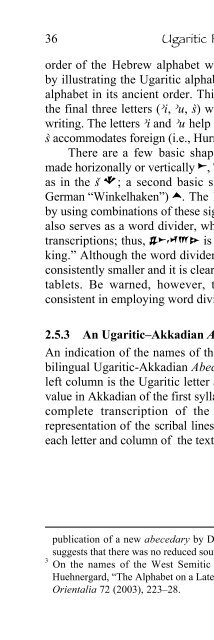A Primer on Ugaritic: Language, Culture, and Literature - enenuru
A Primer on Ugaritic: Language, Culture, and Literature - enenuru
A Primer on Ugaritic: Language, Culture, and Literature - enenuru
Create successful ePaper yourself
Turn your PDF publications into a flip-book with our unique Google optimized e-Paper software.
36<br />
<strong>Ugaritic</strong> <str<strong>on</strong>g>Primer</str<strong>on</strong>g><br />
order of the Hebrew alphabet with some additi<strong>on</strong>s. Furthermore,<br />
by illustrating the <strong>Ugaritic</strong> alphabet in this abecedary, wesee the<br />
alphabet in its ancient order. This makes it easy to recognize that<br />
the final three letters (}i, }u, sì) were later additi<strong>on</strong>s to a system of<br />
writing. The letters }i <strong>and</strong> }u help distinguish vowels, <strong>and</strong> the letter<br />
sì accommodates foreign (i.e., Hurrian) words.<br />
There are a few basic shapes of signs. Wedges are usually<br />
made horiz<strong>on</strong>ally or vertically t, g <strong>and</strong> can also be used at an angle<br />
as in the sû ;asec<strong>on</strong>d basic shape is the angle wedge (or the<br />
German “Winkelhaken”) o. The letters of the alphabet are formed<br />
by using combinati<strong>on</strong>s of these signs. A small versi<strong>on</strong> of the g sign<br />
also serves as a word divider, which is usually marked as a “.” in<br />
transcripti<strong>on</strong>s; thus, bt.mlk is transcribed bt.mlk, “house of the<br />
king.” Although the word divider seems similar to the g sign, it is<br />
c<strong>on</strong>sistently smaller <strong>and</strong> it is clearly differentiated from the g in the<br />
tablets. Be warned, however, that <strong>Ugaritic</strong> is not completely<br />
c<strong>on</strong>sistent in employing word dividers.<br />
2.5.3 An <strong>Ugaritic</strong>–Akkadian Abecedary Tablet<br />
An indicati<strong>on</strong> of the names of the letters may be obtained by the<br />
bilingual <strong>Ugaritic</strong>-Akkadian Abecedary shown in Figure 2.2. The<br />
left column is the <strong>Ugaritic</strong> letter <strong>and</strong> the right column the syllabic<br />
value in Akkadian of the first syllable of the letter name. 3 Part of a<br />
complete transcripti<strong>on</strong> of the text <strong>on</strong> the next page is the<br />
representati<strong>on</strong> of the scribal lines that the scribes used to separate<br />
each letter <strong>and</strong> column of the text.<br />
publicati<strong>on</strong> of a new abecedary by D. Pardee <strong>and</strong> P. Bordreuil (RS 88.2215)<br />
suggests that there was no reduced southern or Canaanite alphabet.<br />
3 On the names of the West Semitic alphabet also see F. M. Cross <strong>and</strong> J.<br />
Huehnergard, “The Alphabet <strong>on</strong> a Late Babyl<strong>on</strong>ian Cuneiform School Tablet,”<br />
Orientalia 72 (2003), 223–28.


